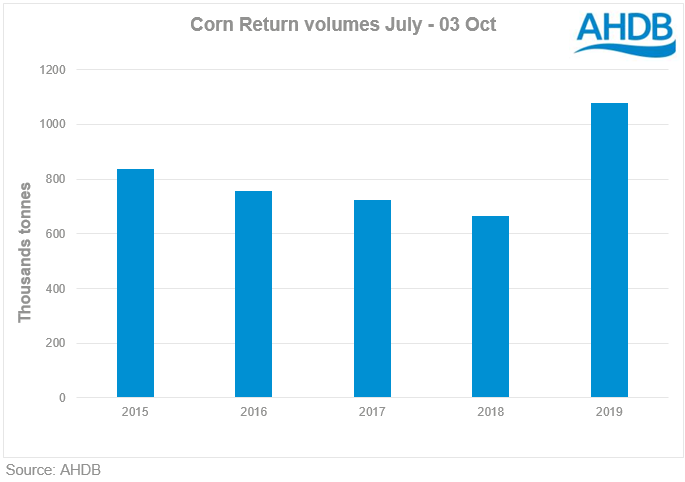Analyst Insight: Where are we in the field of exports?
Thursday, 10 October 2019
Market commentary
- Defra has released their full provisional production results, highlighting above expectation record spring barley yields (read full article here).
- Sterling continued to weaken against the euro from Monday, having fallen by 0.8% for far this week. This provided further support to UK feed wheat futures (Nov-19), which increased £0.50/t yesterday to close at £138.50/t.
- The October USDA WASDE report is to be published later today, giving updated forecasts for crop production, yields and carryout stocks. Analysis of this report will be covered in tomorrow’s Grain Market Daily.
Where are we in the field of exports?
In an update to a previous analyst insight, we examine how much wheat and barley the UK may have exported before Brexit. Reportedly, there is “little room” for new export trade at UK ports due to export schedules at “near to full”.
With the threat of Brexit tariffs fast approaching, any new export trade would be booked close to the 31 October deadline. With ports busy, delays could see export shipments booked for October potentially run into November. Should tariffs be imposed, these shipments could incur third-country tariff costs of €12.00/t if the destination is EU based.
Exports this season so far (using corn return feed wheat volumes as a proxy), have seen elevated levels to ship prior to 31 October. Volumes for July-October delivery have reached record levels of 1.07Mt (to 03 October). With an estimated 16.28Mt wheat harvest this season, this means over 6% has moved off farm so far. However, it must be remembered that the corn return volume sales could be to a port or for domestic usage.
This year, the UK wheat harvest is anticipated to produce a 2.20Mt exportable surplus, making it the largest surplus since 2015/16. In 2015/16, UK wheat exports reached 2.79Mt. Whilst this highlights the UK has the capability of moving a large surplus, there was not the potential loss of EU market access overhanging the market in that season.
Given that corn return volumes do not allow for specific export volume figures, and HMRC data is not available past August, we can look at HMRC data from a comparable season to judge the rate of export progress so far this season.
In 2016, 29.4% of the exportable surplus was exported from July to 01 October. Applying this percentage to 2019’s exportable surplus figure would mean that 646.8Kt should have been moved through this period. However, our proxy suggests 1.07Mt has moved off farm. However, this still leaves 1.55Mt to be exported for the remainder of the season.
November and December are traditionally low months for exports, therefore pressure to export this surplus could build up as the season progresses. Many EU buyers are reportedly wary of booking UK origin because of the threat of tariffs. November and December grain export schedules are reportedly “quiet”. This increase in export pressure could limit any price increases, especially in the context of ample global supply.
A better spell of weather this season has meant feed demand for cereals has lessened. Better pasture growth, coupled with reportedly larger stocks of silage and maize, have impacted this. The non-appearance of the Vivergo biofuels plant this season is also reducing domestic wheat demand. Implementation of E10 biofuel legislation could provide an incentive to open. However, this legislation has not passed Parliament approval to date.
Sign up for regular updates
You can subscribe to receive Grain Market Daily straight to your inbox. Simply fill in your contact details on our online form and select the information you wish to receive.
While AHDB seeks to ensure that the information contained on this webpage is accurate at the time of publication, no warranty is given in respect of the information and data provided. You are responsible for how you use the information. To the maximum extent permitted by law, AHDB accepts no liability for loss, damage or injury howsoever caused or suffered (including that caused by negligence) directly or indirectly in relation to the information or data provided in this publication.
All intellectual property rights in the information and data on this webpage belong to or are licensed by AHDB. You are authorised to use such information for your internal business purposes only and you must not provide this information to any other third parties, including further publication of the information, or for commercial gain in any way whatsoever without the prior written permission of AHDB for each third party disclosure, publication or commercial arrangement. For more information, please see our Terms of Use and Privacy Notice or contact the Director of Corporate Affairs at info@ahdb.org.uk © Agriculture and Horticulture Development Board. All rights reserved.


